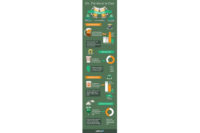Although many historians have coined the Industrial Revolution as a turning point in history, it would be interesting to hear what beer historians might say about the current state of this category in relation to the rest of beer’s history and future. Jeff Nowicki, chief strategy officer with Bump Williams Consulting (BWC), Stratford, Conn., says that the overall category did well in 2014, with volume sales up 1 percent and dollar sales up 3.5 percent, based on data from Chicago-based Information Resources Inc. (IRI) in off-premise multi-outlets and convenience stores.
Nowicki anticipates that this growth trend will continue for the category into the current calendar year. “[In] 2015, I expect to see a better performance for the category with the outcome to come in around 1.5 to 2 percent volume growth and dollar growth in the 4 to 4.5 percent range,” he says.
However, Beth Bloom, food and drink analyst with Chicago-based Mintel, cautions that the beer category could face outside competition from other alcohol categories. “There’s competition from other alcoholic beverages especially with younger consumers, millennials, of drinking age being interested in a variety of products,” she says. “They’re turning to wine and spirits and ready-to-drink beverages and turning away from beer a little bit, still drinking beer but open to drinking other items as well.”
Although the beer category is faring well, the dominant domestic segment has experienced some changes in its market share.
In 2014, the segment’s volume was flat while dollar sales were up 2.7 percent, primarily driven by price increases and premiumization, says Danelle Kosmal, vice president of the beverage alcohol practice at New York-based Nielsen.
“When we break the category into segments, we begin to see more differentiation in performance of beer,” she says. “Domestic above-premium continues to grow and was up 9.1 percent in case volume for 2014.”
BWC’s Nowicki notes that the super-premium segment within domestic has benefited from brands that offer products that touch upon the craft beer style. “Segment leader Michelob Ultra, coupled with Redd’s, Blue Moon and Leinenkugel’s Shandy, continued to fuel the growth in this segment as these are the gateway brands into the craft-style segment,” he says.
For instance, Redd’s Apple Ale, a brand of Chicago-based MillerCoors, a joint venture between SABMiller and Molson Coors Brewing Co., experienced approximately 32 percent growth, while Redd’s Strawberry Ale grew approximately 195 percent during the 52 weeks ending Dec. 28, 2014, in IRI-measured channels.
However, other price tiers within the segment did not fare as well, Nielsen’s Kosmal notes. Premium lights were down 0.6 percent in case volume, and below-premium brands were down 3.5 percent in 2014 versus 2013, she says.
Mintel’s Bloom notes that light beer’s market share has been on the decline for the past five years, with the sub-segment’s volume down 12 percent between 2009 and 2014. For 2014 alone, volume for the sub-segment decreased 3.6 percent, and its market share was at 49 percent compared with 54 percent in 2009, she says.
However, brand owners still are investing in the future of this segment’s leader. MillerCoors garnered consumer attention when it released a limited-edition reincarnation of its Original Lite Can. The packaging was so popular that the company opted to make the packaging change permanent. This marketing initiative was a positive one for the brand and the sub-segment, BWC’s Nowicki says.
Nowicki adds that repositioning has been a strategy within domestic beer, as exemplified by Anheuser-Busch InBev (AB InBev), Leuven, Belgium. AB InBev repositioned the pricing of its Rolling Rock brand from premium to sub-premium and has seen volume and dollar sales growth, he notes.
Although Nowicki anticipates sub-premium will continue to combat volume and dollar sale challenges, the other domestic sub-segments should experience positive results in 2015, he says.







